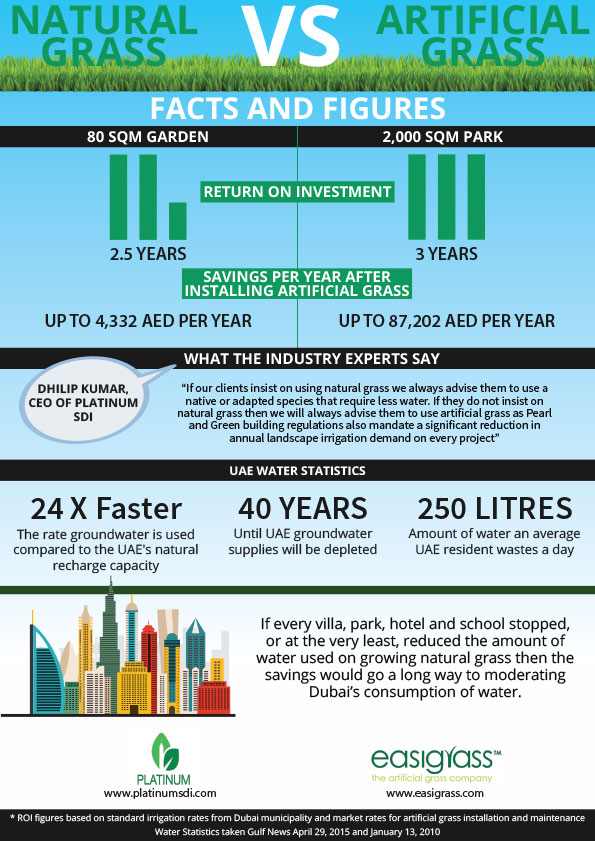Artificial Grass Vs Natural Grass – Water Report
The below report gives you an insight into the savings per year after installing artificial grass
The rapid economic development of The United Arab Emirates has put significant pressure on its natural resources. The staggering success of the UAE is well documented; in a relatively short period of time millions of expats have flocked to the country to take advantage of its flourishing industries. The unprecedented growth of the UAE has also created its most significant environmental challenge so far; water management.
The UAE is one of the driest countries in the world, yet, per capita, it uses 83% more water than the global average; a total of 4.4 trillion litres per day. The UAE is now under serious pressure to become more sustainable.
This unquenchable demand for water is only going to increase as more projects, more residents and more tourists come to the UAE. It is predicted that the demand will see an increase of 44% by 2025 yet the UAE uses its ground water 24 times faster than its natural recharge capacity. At this rate ground water supplies will be depleted within the next 40 years.
General water wastage is a major concern; it is reported that the average UAE resident can waste up to 250L per day. If water conservation and sustainability is a top priority then this worrying statistic needs to be addressed immediately. In order for the UAE to reduce water wastage it has to, very simply, reduce water usage. One way of doing this is through the implementation of artificial grass.
In a recent interview with Dhilip Kumar, CEO of Platinum SDI, a leading sustainable development consultancy firm with several years of experience in the Middle-East region, Dhilip said…
“ If our clients insist on using natural grass we always advise them to use a native or adapted species that require less water. If they do not insist on natural grass then we will always advise them to use artificial grass as Pearl and Green building regulations also mandate a significant reduction in annual landscape irrigation demand on every project”.
This isn’t a new concept; the State of California, for example, actively encourages the use of artificial grass in order to reduce water consumption by offering subsidies for those that have it installed.
One of Dubai’s most innovative landscape architecture practices, desert INK, were early adopters of artificial grass and have been specifying it in many of their recent projects. Will Bennett from desert INK said “despite being a proponent for all things natural in the softscape, we actually prefer to use artificial turf in many of our commercial projects for three main reasons; it provides a permanent ‘green’ surface all year round, environmentally speaking it has far less impact on our water resources than real grass and when we studied the numbers we found that it cost much less than irrigating real lawn, saving our clients’ money”
Will goes on to explain; “Artificial turf, in this part of the world, is a better option than real turf in most scenarios. It’s hardwearing nature makes it ideal for intensively used areas such as playgrounds and sports pitches. It gives us great versatility to design with because we are much less restricted by the maintenance requirements compared with natural turf. For us, it adds value to our designs and can bring the ‘wow’ factor that our clients expect from us”
A difficult part of the learning curve has been to dispel the misconception that ‘green is really green’; Will elaborates, “It’s a false impression that vegetation equals green environmental credentials in this region. This might be correct in temperate climates but in the desert it couldn’t be further from the truth. Maintaining a lush lawn is incredibly intensive; it requires large quantities of water, pesticides and fertilizers as well as labour”.
Easigrass and desert INK developed a cost analysis study to see if artificial turf could be more sustainable from an economic point of view as well as an environmental one. The conclusion of the study was as follows.
An artificial grass garden of 80 square metres
Although the initial investment is considerably higher than that of natural grass after two and a half years the money spent on maintaining natural grass surpasses that of artificial grass. After 2.5 years the savings made by installing artificial grass could be as much as 4,332 AED per year
A commercial installation of 2,000 square metres
On larger projects where maintenance costs are lower the return on investment is 3 years. After this, the savings made by installing artificial grass could be as much as 87,202 AED per year.
Taking into account the water usage figures in the UAE it is clear that action needs to be taken to reduce general water consumption but more specifically water wastage. Artificial grass offers a solution that looks and feels like natural grass yet no water is needed to keep it green. When comparing the cost of natural grass against artificial grass, although the initial investment is higher we see considerable savings made after as short a period as 2.5 years.
If every villa, park, hotel and school stopped, or at the very least, reduced the amount of water used on growing natural grass then the savings would go a long way to moderating Dubai’s consumption of water.
This article is collaboration between Desert Ink, Platinum DSI and Easigrass.
www.desert-ink.com, www.platinumsdi.com
*ROI figures based on standard irrigation rates from Dubai Municipality and market rates for artificial grass installations and maintenance.**Water Statistics taken Gulf News April 29 and 2015 and January 13, 2010.




